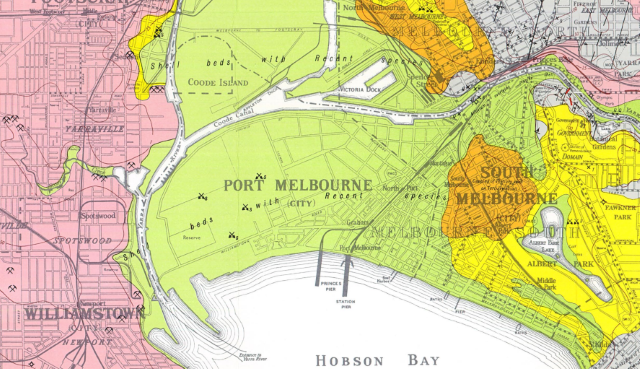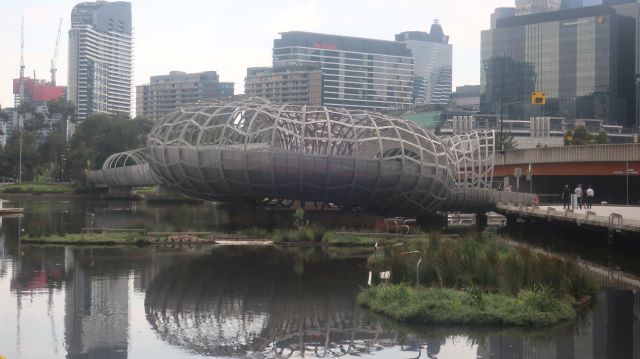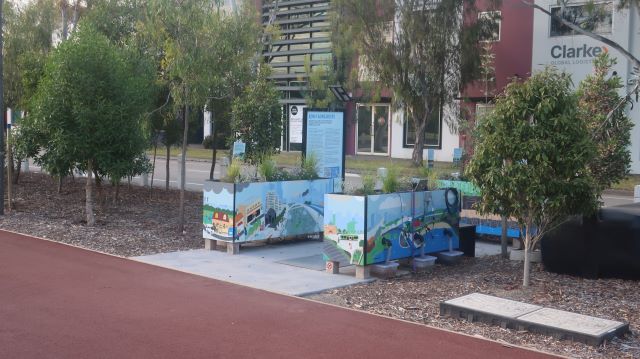Sand and cement in Fishermans Bend
This post was prompted by a stop on the walk Destination Fishermans Bend.
Cement trucks park neatly along the River’s edge on Lorimer Street near where it parts from Todd Road. Cement Australia occupies berths 32, 33 and 24 South Wharf. The Port is vitally also the riverside wharves and not just Swanson Dock and Webb Dock.
Lorimer Street and its immediate hinterland is a centre of the cement and concrete industry. It is important to these industries to locate there, close to the River berths and the construction sites to which they supply their material. Every hour on the road, and on a congested road, is an extra cost to a project.
Cement is the glue that binds gravel, sand and water together to make concrete. Material for making cement is imported from Tasmania and South Australia.
In the early days of Melbourne’s settlement, raw materials were found closer to home.
The pale green in this extract from a Geological map of Victoria illustrates that sand is the very nature of the geology of Port Melbourne. The pink indicates the basalt of Victoria’s volcanic plain to the west.

The legend describes the green area as Quaternary flats, mudflats, beach and estuarine deposits. It covers the entire area we now know as Port Melbourne, Fishermans Bend and Coode Island.
The Quaternary Period is tthe most recent period of geologic time. It is divided into two epochs: the Pleistocene (2.588 million years ago to 11.7 thousand years ago) and the Holocene (11.7 thousand years ago to today).2
The sand was formed in geological time, but was used up very quickly.
Massive amounts of sand were extracted from Fishermans Bend. 2,052 weekly licenses were issued in 1874. Prior to 1873, no records were kept by the Department of Lands. The industry was lightly regulated. Licenses were issued, but largely for the income. Monitoring such a large area was difficult and it wasn’t actively pursued. The requirement to fill the holes created by removing sand was poorly complied with.
A rare investigation followed a complaint from Mr White, yacht and boat builder of Williamstown. White complained that sand was being removed without license from either side of Williamstown Rd. He asserted that the sand was being stolen leaving ‘immense’ holes in which a man might drown. It appears that Mr White was frustrated by the Department’s failure to follow up on the issue: “if the department is not interested enough to stop this, public opinion must.”
A Mr Bannerman was sent to investigate. He set off early, catching the train from Newport. He crossed the River, but didn’t see any sand stealing though the evidence of theft was plain to see. The offence occurred either early in the morning or late at night. He complained that “it is not to be supposed and can scarce be expected that I should be down there regularly at so early an hour, or remain there so late at night as these sand stealers go after the sand.”
It seems that the Department was concerned, not only with the loss of the resource, but the revenue forgone. When the Coode Canal was cut in the 1880s, a vast sand stockpile was created. The sand was of the highest quality, like ‘baker’s flour’. Rather than selling it as previously arranged to the Melbourne Harbor Trust for a fixed price, sand carters were invited to buy it at a higher price.
It has been said that the State Savings Bank of Victoria might have considered building more housing in Garden City but the need to raise the floor levels because of excessive sand excavation led to an unacceptable cost to each dwelling.
Sources
1Geological Survey of Victoria, 1959. Melbourne & suburbs 40 chains to 1 inch, geological map. Department of Mines, Victoria.
2A third epoch, the Anthropocene, has been proposed but is not yet officially recognized by the International Commission of Stratigraphy). https://en.wikipedia.org/wiki/Quaternary
PROV VPRS 3252/P/000 Unit 000522




Leave a Reply